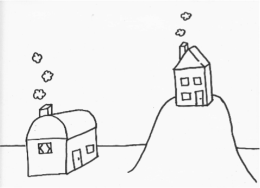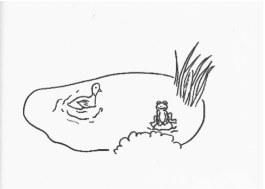Abstract
‘Bridging’ allows for the use of a definite referent that has not been previously introduced in the discourse, because both speaker and hearer know it refers to a previously mentioned indefinite referent, based on their world knowledge (Asher and Lascarides, J Semant 15(1):83–113, 1998). Avrutin and Coopmans, BUCLD 24: Proceedings of the 24th annual Boston University Conference on Language Development Boston. Cascadilla Press, Somerville (2000) demonstrated that four-year-old children already have knowledge of bridging inferences and that they are able to implement their knowledge of this syntax-discourse interface phenomenon in a truth-value judgment task relatively well, while three-year-olds performed significantly worse. In order to investigate the possibility that the poor performance of pre-school children was due to task-specific properties, and specifically high cognitive demand, the present study investigated bridging comprehension of 89 Dutch three- and four-year-old children with the Coloring Book, a new experimental method which tests children’s language comprehension in a more ecological manner (Pinto and Zuckerman, Behavior Research Methods 1–20, 2018). The results show that performance on bridging comprehension strongly improved; four-year-olds performed 95% adultlike and three-year-olds, 91%. Thus, children preferred a linguistic interpretation based on bridging over an interpretation based on deixis. In addition, the present study explored the effects of animacy and the degree to which the two referents form a unity on children’s comprehension of bridging constructions.
Access this chapter
Tax calculation will be finalised at checkout
Purchases are for personal use only
Notes
- 1.
An anonymous reviewer pointed out that in the inanimate condition, the visual competitor was sometimes an animate entity (i.e., Item 2 and Item 6). However, a closer examination showed that children’s responses were no different on these items than on the other items.
References
Akaike, H. (2011). Akaike’s information criterion. In M. Lovric (Ed.), International encyclopedia of statistical science. Berlin, Heidelberg: Springer. https://doi.org/10.1007/978-3-642-04898-2_110.
Asher, N., & Lascarides, A. (1998). Bridging. Journal of Semantics, 15(1), 83–113.
Avrutin, S., & Coopmans, P. (2000). Children who build bridges. In: BUCLD 24: Proceedings of the 24th annual Boston University Conference on Language Development Boston (pp. 80–91). Somerville, MA.: Cascadilla Press.
Bates, D., Maechler, M., Bolker, B., & Walker, S. (2015). Fitting linear mixed effects models using lme4. Journal of Statistical Software, 67(1), 1–48.
Chondrogianni, V., & Marinis, T. (2015). Production of definite and indefinite articles in typically developing English-speaking children and children with SLI. Lingua, 155, 9–28.
Clark, H. (1977). Bridging. In P. N. Johnson-Laird & P. C. Wason (Eds.), Thinking: Readings in cognitive science (pp. 411–420). Cambridge: Cambridge University Press.
Fritzley, V. H., & Lee, K. (2003). Do young children always say yes to yes-no question? A metadevelopmental study of the affirmation bias. Child Development, 74, 1297–1313.
Garrod, S., & Terras, M. (2000). The contribution of lexical and situational knowledge to resolving discourse roles: Bonding and resolution. Journal of Memory and Language, 42(4), 526–544.
Gerard, J., Lidz, J., Zuckerman, S., & Pinto, M. (2018). The acquisition of adjunct control is colored by the task. Glossa: A Journal of General Linguistics, 3(1), 1–22.
Hawkins, J. A. (1991). On (in)definite articles: implicatures and (un)grammaticality prediction. Journal of Linguistics, 27(2), 405–442.
Heim, I. (1982). The semantics of indefinite and definite noun phrases. PhD diss., University of Massachusetts.
Karttunen, L. (1968). What makes definite noun phrases definite?. Santa Monica, CA: The Rand Coporation.
Marinis, T., & Saddy, D. (2013). Parsing the passive: Comparing children with specific language impairment to sequential bilingual children. Language Acquisition, 20(2), 155–179.
Okanda, M., & Itakura, S. (2010). When do children exhibit a yes bias? Child Development, 81(2), 568–580.
Pinto, M., & Zuckerman, S. (2015). A new coloring method for testing language comprehension. Paper presented in SuB 20, Teubingen.
Pinto, M., & Zuckerman, S. (2017). Color your first intuition: A study on antecedent selection using the Coloring Book method. Paper presented in GALA 13, Palma de Mallorca.
Pinto, M., & Zuckerman, S. (2018). Coloring book, a new method for testing language comprehension. Behavior Research Methods 1–20. https://doi.org/10.3758/s13428-018-1114-8.
R Core Team. (2016). R: A language and environment for statistical computing. R Foundation for Statistical Computing. https://www.R-project.org/.
Steffensen, M. S. (1978). Satisfying inquisitive adults: Some simple methods of answering yes-no questions. Journal of Child Language, 5, 221–236.
Van der Weert, C. (1999). Syntax discourse interface: An investigation into incorporation and accommodation in child language development (MA thesis). Utrecht University.
Van Hout, A., Harrigan, K., & de Villiers, J. (2010). Asymmetries in the acquisition of definite and indefinite NPs. Lingua, 120(8), 1973–1990.
Zuckerman, S., Pinto, M., Koutamanis, E., & van Spijk, Y. (2016). A new method for language comprehension reveals better performance on passive and principle B constructions. In J. Scott & D. Waughtal (Eds.), BUCLD 40: Proceedings of the 40th annual Boston University Conference on Language Development, Boston (pp. 443–456). Somerville, MA.: Cascadilla Press.
Acknowledgements
We thank Prof. Jeannette Schaeffer for her feedback on the design of the study and on an earlier version of this paper, and Welmoed Bosch for drawing the pictures used in our experiment. We also thank the audience of Gala 13 for their challenging questions and valuable comments.
Author information
Authors and Affiliations
Corresponding author
Editor information
Editors and Affiliations
Appendices
Appendix 1: Bridging Items
Inanimate/non-unity
-
1.
Er vaart een bootje voorbij. De vlag is rood. ‘There is a boat sailing by. The flag is red.’

-
2.
Er hangt was aan de waslijn. De broek is groen. ‘There is laundry hanging on the clothesline. The pants are green.’

-
3.
Er staat een bank in de kamer. Het kussen is oranje. ‘There is a couch standing in the room. The pillow is orange.’

Inanimate/unity
-
4.
Er rijdt een auto voorbij. De wielen zijn oranje. ‘There is a car passing by. The wheels are orange.’

-
5.
Er staat een huis op de berg. Het dak is rood. ‘There is a house on the mountain. The roof is red.’

-
6.
Er ligt een pop op het bed. Het haar is bruin. ‘There is a doll lying on the bed. The hair is brown.’

Animate/non-unity
-
7.
Er staat een clown op een krukje. De hoed is blauw. ‘There is a clown standing on a stool. The hat is blue.’

-
8.
Er is een jongen aan het eten. De broek is groen. ‘There is a boy eating. The pants are green.’

-
9.
Er is een moeder aan het koken. De jurk is rood. ‘There is a mother cooking. The dress is red.’

Animate/unity
-
10.
Er zit een kat in de mand. De staart is bruin. ‘There is a cat sitting in the basket. The tail is brown.

-
11.
Er zit een muis op de grond. De oren zijn blauw.‘ There is a mouse sitting on the ground. The ears are blue.’

-
12.
Er loopt een prinses op het gras. De kroon is geel. ‘There is a princess on the grass. The crown is yellow.’

Appendix 2: Fillers
Fillers type 1
-
1.
Er zwemt een eend in de vijver. Het eendje is geel. ‘There is a duck swimming in the pond. The duck is yellow.’

-
2.
Er vliegt een vogel voorbij. De vogel is blauw. ‘There is a bird flying by. The bird is yellow.’

-
3.
Er staat een huis naast het meer. De deur van het huis is bruin. ‘There is a house standing next to the lake. The door of the house is brown.’

Fillers type 2
-
4.
Er zijn kinderen aan het spelen. De bal is groen. ‘There is a child playing. The ball is green.’

-
5.
Er rijdt een trein voorbij. De wielen zijn rood. ‘There is a train passing by. The wheels are red.’

-
6.
Er loopt een mevrouw door de regen. De paraplu is oranje. ‘There is a lady walking through the rain. The umbrella is orange.’

Rights and permissions
Copyright information
© 2020 Springer Nature B.V.
About this chapter
Cite this chapter
Bosch, J.E., Zuckerman, S., Pinto, M. (2020). The Acquisition of ‘Bridging’ Tested with the Coloring Book Method. In: Guijarro-Fuentes, P., Suárez-Gómez, C. (eds) New Trends in Language Acquisition Within the Generative Perspective. Studies in Theoretical Psycholinguistics, vol 49. Springer, Dordrecht. https://doi.org/10.1007/978-94-024-1932-0_12
Download citation
DOI: https://doi.org/10.1007/978-94-024-1932-0_12
Published:
Publisher Name: Springer, Dordrecht
Print ISBN: 978-94-024-1931-3
Online ISBN: 978-94-024-1932-0
eBook Packages: Social SciencesSocial Sciences (R0)



















